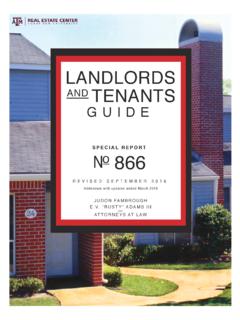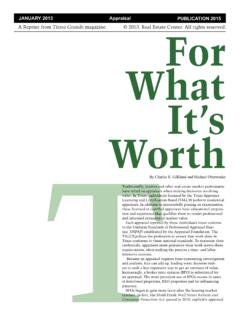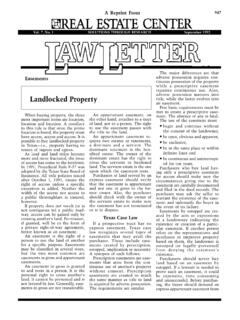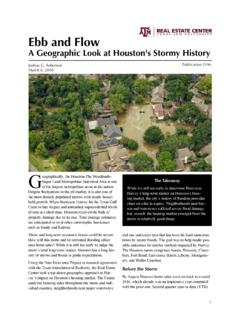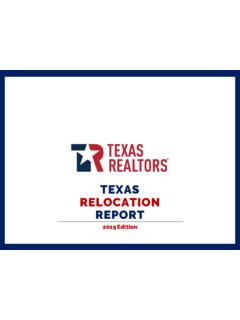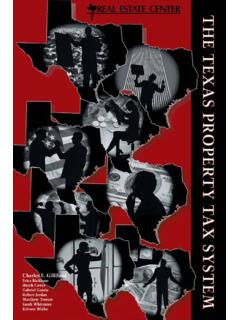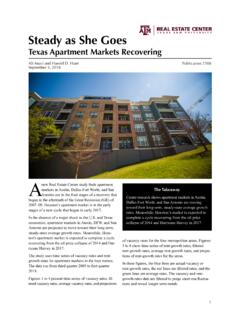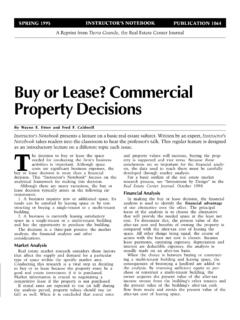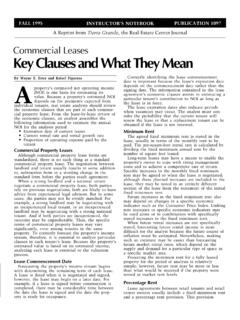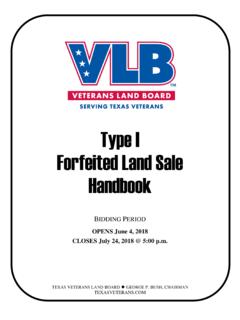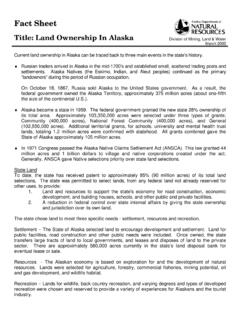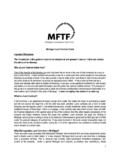Transcription of Buying Rural Land
1 OCTOBER 1997 PUBLICATION 1196A Reprint from Tierra Grande, the Real Estate Center JournalLAND DEVELOPMENTBy Charles E. GillilandMany potential buyers find theprocess of purchasing ruralland inherently stressful. Gen-erally, such purchases represent asubstantial investment; mistakes areespecially costly. Inexperienced buyersmay be unaware of possible of the underlying financial risks,they may be wise to engage an experi-enced real estate agent for assistance. Inaddition, some basic guidelines Buying involves four phases: locating the property, identifying desired land character-istics and property rights, valuing the property and completing the on Specific LocationsOften cited as the most importantattribute of real estate, location identi-fies the physical features of the propertyand defines its specific characteristicswithin the context of surrounding prop-erties. More than any other single in-fluence, location defines the potentialuses of a a property begins with a listof specific property attributes sought bythe buyer.
2 Buyers should clearly definethe major land uses they far are they willing to drive tothe property? How close should it be toa town? The distance issue also is af-fected by accessibility. Does the prop-erty have frontage on a paved road? Arebuyers willing to sacrifice easy accessfor solitude and scenic beauty? Do theywant access to a Rural water supply sys-tem or are they willing to drill a well?The answers focus the search on location decision involves geo-graphic attributes. If buyers seek ruggedHill Country beauty with abundant wild-life, they will focus on Central , if they desire an attractiverecreational site with easy access, anearby ranch may fit their needs. Forinvestment buyers, the path of progressdetermines Essential FeaturesNext, potential buyers should iden-tify the essential features in their de-sired property. Do they want trees? Isa running creek a must?
3 How much landis enough? Frequently buyers find thatthey have acquired too little or too muchland to effectively accomplish theirdesired use. An honest appraisal of needshelps the buyer avoid the size question depends onhow much the buyer can afford to spendon land . Competing buyers and sellershave set a typical price per acre in themarket, and the amount potential buy-ers can afford depends on their attributes being equal, distancefrom urban areas plays a determiningrole in land prices. For example, thecloser the tract lies to San Antonio thehigher the price per acre and the smallerthe property many potential buyers a buyer needs a certain amount ofland, for example 600 acres for a huntingproperty in the Hill Country, then typi-cal price per acre becomes a criticalissue. Price can determine size, or sizecan determine location. To clearly evalu-ate this size-distance tradeoff, potentialbuyers must know how much they canafford to spend.
4 The general levels ofland prices in various Texas areas areavailable in the Real Estate Center landvalue reports. These reports are pub-lished periodically, and the basic infor-mation is available at the Center sinternet site ( ).Understand Property RightsProperty characteristics define poten-tial physical uses while property rightsdefine legal ownership. Combined, thetwo create a market value for the clear understanding of these influ-ences assists in price buyers should identify bothphysical attributes and buyers should view the prop-erty as if they eventually intend to sellit. If an attribute repels potential buyers,the impact should be considered forfuture rights are less tangible andencompass issues from verifyingownership to identifying easements. Be-cause they specify the potential legaluses of the land , available property rightsmay be more important than physicalfeatures.
5 If the structure of ownershipprohibits a highly prized use, that defectwill exert an impact on the value. Forexample, an attractive ranch with apipeline easement through its center isless appealing than one without it. Untilthe property rights issue has been ad-dressed, potential buyers have little basisfor estimating a reasonable significant property rights is-sues include: existing lease provi-sions, undivided interests, mineralrights ownership, restrictive covenants,environmental regulations for endan-gered species, hazardous substances orwetlands, historical preservation regu-lations and property provisions. Initially a grazing orfarming lease may seem agricultural leases run for a shortperiod; many are renewed , lease provisions may exert adecided influence on the purchase pro-cess. The right-of-first-refusal, oftengranted to long-term tenants, can com-plicate matters for a buyer.
6 Specifically,the potential buyer invests time andeffort in negotiating the best pricepossible only to see the ten-ant step in to purchase theland. Potential buyers mayavoid negotiating for proper-ties with a interest. An-other difficulty can arisewhen several individualsown undivided interests inthe land , such as heirs to afamily ranch or farm. Al-though it does not automati-cally guarantee problems,undivided interests compli-cate the negotiation processwhen all owners do not wishto sell. Purchasing such prop-erty may present a negotiat-ing challenge. All ownersmust be committed to a of an undivided interest fromone owner is possible, followed by ac-tion to partition the land . However, thevalue of a partial land interest is likelyto be less than full ownership of onlypart of the land . For example, a buyerwould likely pay less per acre for a 50percent interest in a 100-acre tract thanfor full ownership of 50 rights.
7 Mineral ownership canbe important for land buyers, especiallywhen less than half of the mineralstransfer with ownership. Mineral own-ers dominate surface owners. This meansthat a mineral owner, or the lessee, canenter the property to extract the mineralswithout obtaining permission from thelandowner. Thus, if minerals belong toanother person, a landowner has littlecontrol over oil and gas drilling. Further-more, if the current owner has executeda lease with a producer, that lease re-mains in force even if the mineralstransfer with the rights have been a fixture inthe Texas land market for many yearsand do not doom a sale. However, apotential buyer should not purchase prop-erty without inquiring about the possi-bility of mineral covenants. Some landtitles contain restrictive covenants thatconstrain use. Restrictive covenants aresometimes called deed restrictions, andthey typically attempt to ensure a par-ticular level of land use.
8 A commonlyencountered deed restriction requires anowner to build a home with a specifiedminimum area. Restrictive covenantshave an effect similar to zoning. How-ever, enforcement of restrictivecovenants for Rural land generally de-pends on legal action by individualsrather than on government problems with restrictive cov-enants occur when a buyer is solution lies in identifying possiblerestrictions before completing the trans-action. Then both buyer and seller cantake the restrictions into regulations. Environ-mental regulations may signal potentialproblems for landowners. Consequently,buyers should identify possibleissues prior to closing. Like restrictivecovenants, endangered species regula-tions or the presence of wetlands canlimit land uses. The presence of hazard-ous substances may create an onerousliability for anyone taking title to Real Estate Center has several pub-lications on such endangered species are pro-tected under federal law, including re-quired preservation of their of land harboring an endangeredanimal likely will find severe restrictionson land use.
9 In some cases,restrictions have halted most humanactivity in endangered species one can predict whether a par-ticular property may become the homeof an endangered species as more en-dangered plants and animals are iden-tified. However, the buyer s awarenessof existing endangered species habitatand of the identity of threatened speciesthat may acquire endangered status preservation regulations. Likeenvironmental regulations, historicpreservation regulations can affectowners of historical sites. When a landsale includes a historical structure, own-ers often regard the site with , buyers may find historic pres-ervation restrictions sites need not prevent a trans-action if buyers know the implicationsbefore purchase and negotiate taxes. Another potentialstumbling block for land buyers thatcould affect price negotiations is theappraisal method used to determinetaxes.
10 If the current owner has beentaxed under the Texas open-space pro-vision, the liability for a potential roll-back tax passes to the new treatment depends onestablishing a record of past and con-tinuing land use for agricul-ture or timber wildlife habitatqualifies as an agricultural useunder certain the land receives open-space treatment, property taxliability depends on agricul-tural use value rather thanmarket value. Often, open-space status results in a sub-stantial tax reduction. How-ever, when land use changes,the Texas Property Tax Codeimposes an additional taxequal to the difference be-tween taxes based on marketvalue and taxes based on usevalue for the past five also imposes a liability forinterest on the rollback , open-space tax treatmentcreates no difficulties, but potential prob-lems emerge when the seller has ben-efited from reduced taxes and a buyeradopts a nonqualifying land use soonafter purchase.
